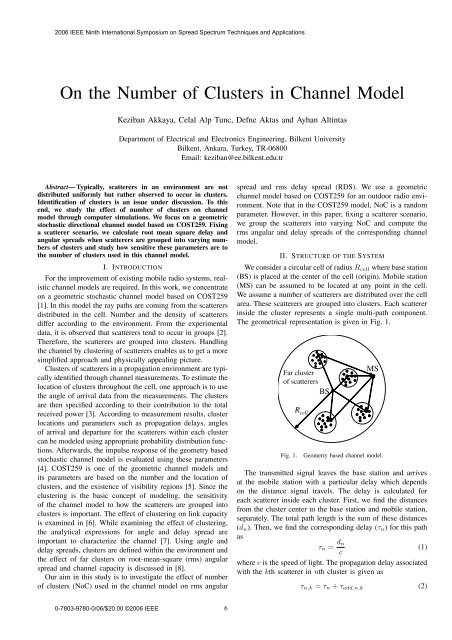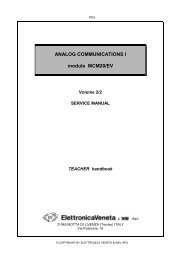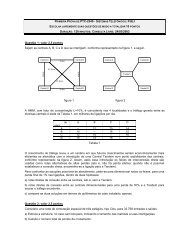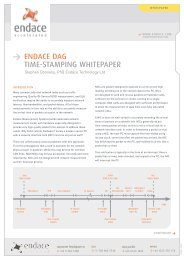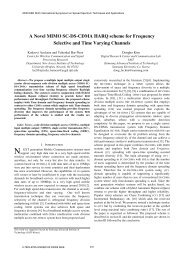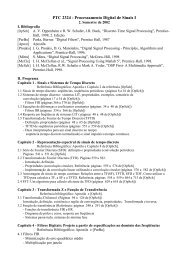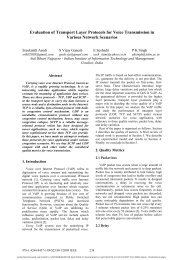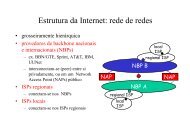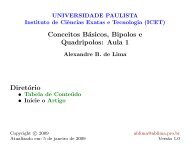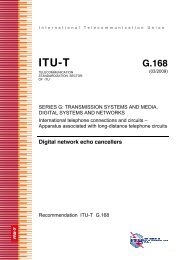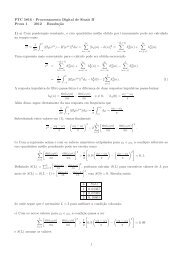On the Number of Clusters in Channel Model
On the Number of Clusters in Channel Model
On the Number of Clusters in Channel Model
You also want an ePaper? Increase the reach of your titles
YUMPU automatically turns print PDFs into web optimized ePapers that Google loves.
2006 IEEE N<strong>in</strong>th International Symposium on Spread Spectrum Techniques and Applications<br />
<strong>On</strong> <strong>the</strong> <strong>Number</strong> <strong>of</strong> <strong>Clusters</strong> <strong>in</strong> <strong>Channel</strong> <strong>Model</strong><br />
Keziban Akkaya, Celal Alp Tunc, Defne Aktas and Ayhan Alt<strong>in</strong>tas<br />
Department <strong>of</strong> Electrical and Electronics Eng<strong>in</strong>eer<strong>in</strong>g, Bilkent University<br />
Bilkent, Ankara, Turkey, TR-06800<br />
Email: keziban@ee.bilkent.edu.tr<br />
Abstract— Typically, scatterers <strong>in</strong> an environment are not<br />
distributed uniformly but ra<strong>the</strong>r observed to occur <strong>in</strong> clusters.<br />
Identification <strong>of</strong> clusters is an issue under discussion. To this<br />
end, we study <strong>the</strong> effect <strong>of</strong> number <strong>of</strong> clusters on channel<br />
model through computer simulations. We focus on a geometric<br />
stochastic directional channel model based on COST259. Fix<strong>in</strong>g<br />
a scatterer scenario, we calculate root mean square delay and<br />
angular spreads when scatterers are grouped <strong>in</strong>to vary<strong>in</strong>g numbers<br />
<strong>of</strong> clusters and study how sensitive <strong>the</strong>se parameters are to<br />
<strong>the</strong> number <strong>of</strong> clusters used <strong>in</strong> this channel model.<br />
I. INTRODUCTION<br />
For <strong>the</strong> improvement <strong>of</strong> exist<strong>in</strong>g mobile radio systems, realistic<br />
channel models are required. In this work, we concentrate<br />
on a geometric stochastic channel model based on COST259<br />
[1]. In this model <strong>the</strong> ray paths are com<strong>in</strong>g from <strong>the</strong> scatterers<br />
distributed <strong>in</strong> <strong>the</strong> cell. <strong>Number</strong> and <strong>the</strong> density <strong>of</strong> scatterers<br />
differ accord<strong>in</strong>g to <strong>the</strong> environment. From <strong>the</strong> experimental<br />
data, it is observed that scatterers tend to occur <strong>in</strong> groups [2].<br />
Therefore, <strong>the</strong> scatterers are grouped <strong>in</strong>to clusters. Handl<strong>in</strong>g<br />
<strong>the</strong> channel by cluster<strong>in</strong>g <strong>of</strong> scatterers enables us to get a more<br />
simplified approach and physically appeal<strong>in</strong>g picture.<br />
<strong>Clusters</strong> <strong>of</strong> scatterers <strong>in</strong> a propagation environment are typically<br />
identified through channel measurements. To estimate <strong>the</strong><br />
location <strong>of</strong> clusters throughout <strong>the</strong> cell, one approach is to use<br />
<strong>the</strong> angle <strong>of</strong> arrival data from <strong>the</strong> measurements. The clusters<br />
are <strong>the</strong>n specified accord<strong>in</strong>g to <strong>the</strong>ir contribution to <strong>the</strong> total<br />
received power [3]. Accord<strong>in</strong>g to measurement results, cluster<br />
locations and parameters such as propagation delays, angles<br />
<strong>of</strong> arrival and departure for <strong>the</strong> scatterers with<strong>in</strong> each cluster<br />
can be modeled us<strong>in</strong>g appropriate probability distribution functions.<br />
Afterwards, <strong>the</strong> impulse response <strong>of</strong> <strong>the</strong> geometry based<br />
stochastic channel model is evaluated us<strong>in</strong>g <strong>the</strong>se parameters<br />
[4]. COST259 is one <strong>of</strong> <strong>the</strong> geometric channel models and<br />
its parameters are based on <strong>the</strong> number and <strong>the</strong> location <strong>of</strong><br />
clusters, and <strong>the</strong> existence <strong>of</strong> visibility regions [5]. S<strong>in</strong>ce <strong>the</strong><br />
cluster<strong>in</strong>g is <strong>the</strong> basic concept <strong>of</strong> model<strong>in</strong>g, <strong>the</strong> sensitivity<br />
<strong>of</strong> <strong>the</strong> channel model to how <strong>the</strong> scatterers are grouped <strong>in</strong>to<br />
clusters is important. The effect <strong>of</strong> cluster<strong>in</strong>g on l<strong>in</strong>k capacity<br />
is exam<strong>in</strong>ed <strong>in</strong> [6]. While exam<strong>in</strong><strong>in</strong>g <strong>the</strong> effect <strong>of</strong> cluster<strong>in</strong>g,<br />
<strong>the</strong> analytical expressions for angle and delay spread are<br />
important to characterize <strong>the</strong> channel [7]. Us<strong>in</strong>g angle and<br />
delay spreads, clusters are def<strong>in</strong>ed with<strong>in</strong> <strong>the</strong> environment and<br />
<strong>the</strong> effect <strong>of</strong> far clusters on root-mean-square (rms) angular<br />
spread and channel capacity is discussed <strong>in</strong> [8].<br />
Our aim <strong>in</strong> this study is to <strong>in</strong>vestigate <strong>the</strong> effect <strong>of</strong> number<br />
<strong>of</strong> clusters (NoC) used <strong>in</strong> <strong>the</strong> channel model on rms angular<br />
spread and rms delay spread (RDS). We use a geometric<br />
channel model based on COST259 for an outdoor radio environment.<br />
Note that <strong>in</strong> <strong>the</strong> COST259 model, NoC is a random<br />
parameter. However, <strong>in</strong> this paper, fix<strong>in</strong>g a scatterer scenario,<br />
we group <strong>the</strong> scatterers <strong>in</strong>to vary<strong>in</strong>g NoC and compute <strong>the</strong><br />
rms angular and delay spreads <strong>of</strong> <strong>the</strong> correspond<strong>in</strong>g channel<br />
model.<br />
II. STRUCTURE OF THE SYSTEM<br />
We consider a circular cell <strong>of</strong> radius R cell where base station<br />
(BS) is placed at <strong>the</strong> center <strong>of</strong> <strong>the</strong> cell (orig<strong>in</strong>). Mobile station<br />
(MS) can be assumed to be located at any po<strong>in</strong>t <strong>in</strong> <strong>the</strong> cell.<br />
We assume a number <strong>of</strong> scatterers are distributed over <strong>the</strong> cell<br />
area. These scatterers are grouped <strong>in</strong>to clusters. Each scatterer<br />
<strong>in</strong>side <strong>the</strong> cluster represents a s<strong>in</strong>gle multi-path component.<br />
The geometrical representation is given <strong>in</strong> Fig. 1.<br />
Far cluster<br />
<strong>of</strong> scatterers<br />
BS<br />
Fig. 1.<br />
R cell<br />
MS<br />
Geometry based channel model.<br />
The transmitted signal leaves <strong>the</strong> base station and arrives<br />
at <strong>the</strong> mobile station with a particular delay which depends<br />
on <strong>the</strong> distance signal travels. The delay is calculated for<br />
each scatterer <strong>in</strong>side each cluster. First, we f<strong>in</strong>d <strong>the</strong> distances<br />
from <strong>the</strong> cluster center to <strong>the</strong> base station and mobile station,<br />
separately. The total path length is <strong>the</strong> sum <strong>of</strong> <strong>the</strong>se distances<br />
(d n ). Then, we f<strong>in</strong>d <strong>the</strong> correspond<strong>in</strong>g delay (τ n ) for this path<br />
as<br />
τ n = d n<br />
(1)<br />
c<br />
where c is <strong>the</strong> speed <strong>of</strong> light. The propagation delay associated<br />
with <strong>the</strong> kth scatterer <strong>in</strong> nth cluster is given as<br />
τ n,k = τ n + τ add,n,k (2)<br />
0-7803-9780-0/06/$20.00 ©2006 IEEE<br />
6
where τ add,n,k is <strong>the</strong> additional delay for <strong>the</strong> correspond<strong>in</strong>g<br />
scatterer. The additional delay for each scatterer <strong>in</strong>side <strong>the</strong><br />
cluster is modeled as a Laplacian distributed random variable<br />
with probability density function (pdf) [4]:<br />
f (τ add,n,k )= √ 1 (<br />
exp − √ )<br />
2|τ add,n,k | (3)<br />
2<br />
The rms delay spread is <strong>the</strong>n computed as [9]:<br />
√ ∣∣∣∣ ∑<br />
n,k<br />
σ τ =<br />
τ (∑<br />
n,k<br />
2 n,k<br />
−<br />
τ )2 ∣<br />
n,k ∣∣∣<br />
(4)<br />
N st N st<br />
where N st is <strong>the</strong> total number <strong>of</strong> scatterers.<br />
S<strong>in</strong>ce COST259 is a directional channel model, we need to<br />
compute <strong>the</strong> angle <strong>of</strong> each multipath component. Firstly, <strong>the</strong><br />
angle between <strong>the</strong> center <strong>of</strong> <strong>the</strong> cluster and <strong>the</strong> mobile station<br />
is calculated and denoted by ¯ϕ. Then, <strong>the</strong> angle <strong>of</strong> arrival<br />
correspond<strong>in</strong>g to <strong>the</strong> kth scatterer <strong>in</strong> nth cluster is found from<br />
[4] as<br />
ϕ n,k =¯ϕ + ϕ add,n,k (5)<br />
where ϕ add,n,k is <strong>the</strong> additional shift <strong>in</strong> angle <strong>of</strong> arrival for <strong>the</strong><br />
kth scatterer. This angle is also assumed to have a Laplacian<br />
distribution. The rms angular spread is computed <strong>in</strong> a similar<br />
fashion as <strong>the</strong> rms delay spread.<br />
The impulse response <strong>of</strong> <strong>the</strong> channel is <strong>the</strong>n obta<strong>in</strong>ed as:<br />
∑N c<br />
∑N s<br />
[<br />
H(t, ϕ) = e<br />
jθ n,k<br />
δ(t − τ n,k )δ(ϕ − ϕ n,k ) ] (6)<br />
n=1 k=1<br />
where N c denotes <strong>the</strong> number <strong>of</strong> clusters and N s denotes <strong>the</strong><br />
number <strong>of</strong> <strong>the</strong> scatterers with<strong>in</strong> <strong>the</strong> cluster and θ n,k is <strong>the</strong> phase<br />
shift associated with <strong>the</strong> {n, k}th scatterer and is modeled as<br />
uniformly distributed.<br />
III. THE METHOD FOR CLUSTERING OF THE SCATTERERS<br />
Typically <strong>the</strong> scatterers are not distributed uniformly with<strong>in</strong><br />
<strong>the</strong> cell area. However, it is usually not clear how to group<br />
<strong>the</strong> scatterers <strong>in</strong>to clusters for a given scenario.<br />
We use k-means algorithm to group a given set <strong>of</strong> scatterers<br />
<strong>in</strong>to N c clusters [10]. In <strong>the</strong> k-means algorithm group<strong>in</strong>g <strong>of</strong><br />
scatterers <strong>in</strong>to N c clusters is based on <strong>the</strong> relative Euclidean<br />
distances <strong>of</strong> geometric centroids <strong>of</strong> clusters to each o<strong>the</strong>r. In<br />
a recent paper, k-means algorithm with a different distance<br />
metric is used to identify clusters from measurement data [11].<br />
In order to study <strong>the</strong> effect <strong>of</strong> NoC used <strong>in</strong> <strong>the</strong> channel<br />
model on channel statistics we vary <strong>the</strong> number <strong>of</strong> clusters N c ,<br />
from 2 to N st , <strong>the</strong> number <strong>of</strong> total scatterers, and compute <strong>the</strong><br />
RDS and rms angular spread for each value <strong>of</strong> N c . Note that<br />
N c = N st corresponds to <strong>the</strong> case where each scatterer is a<br />
cluster itself.<br />
IV. NUMERICAL RESULTS<br />
The scatterer scenario considered is illustrated <strong>in</strong> Fig. 2<br />
(a). Radius <strong>of</strong> <strong>the</strong> cell (RC) is taken as 2km. Two different<br />
scenarios are considered where <strong>the</strong> mobile station is located<br />
at (0,-500) and (0,-1500), so that <strong>the</strong> mobile distance from <strong>the</strong><br />
base station (MD) is 0.5km and 1.5km, respectively. Figs. 3<br />
and 4 compare <strong>the</strong> RDS as a function <strong>of</strong> NoC for two different<br />
mobile locations and two values <strong>of</strong> total number <strong>of</strong> scatterers<br />
(N<strong>of</strong>Sc). For <strong>the</strong> computation <strong>of</strong> rms values <strong>the</strong> results are<br />
averaged over 2,000 realizations.<br />
y (m)<br />
2000<br />
1500<br />
1000<br />
500<br />
0<br />
500<br />
1000<br />
Scatterer Geometry<br />
X<br />
BS<br />
1500<br />
X<br />
MS<br />
2000<br />
2000 1500 1000 500 0 500 1000 1500 2000<br />
x (m)<br />
(a) The scenario where 200 scatterers are randomly<br />
distributed throughout <strong>the</strong> cell.<br />
Delay (sec)<br />
10<br />
9<br />
8<br />
7<br />
6<br />
5<br />
4<br />
3<br />
2<br />
1<br />
0<br />
50 0 50 100 150 200 250<br />
Angle (degree)<br />
(b) Delay vs angle distribution for <strong>the</strong> scenario considered<br />
Fig. 2.<br />
Scatterer scenario.<br />
From Figs. 3 and 4, it is observed that as NoC <strong>in</strong>creases,<br />
<strong>the</strong> RDS quickly converges to <strong>the</strong> limit<strong>in</strong>g value. The limit<strong>in</strong>g<br />
value corresponds to <strong>the</strong> case where each <strong>in</strong>dividual scatterer<br />
is considered a cluster, i.e., N c = N st . It is noted that <strong>the</strong><br />
limit<strong>in</strong>g value depends on <strong>the</strong> number <strong>of</strong> scatterers (N<strong>of</strong>Sc),<br />
as shown <strong>in</strong> Figs. 3 and 4, s<strong>in</strong>ce <strong>the</strong> scatterer locations are<br />
different <strong>in</strong> <strong>the</strong> two scenarios. However, when NoC is small<br />
(e.g. less than 20), <strong>the</strong> RDS is more dependent on NoC, s<strong>in</strong>ce<br />
path delays <strong>of</strong> scatterers <strong>in</strong>side a cluster do not approximate<br />
<strong>the</strong> actual delay values close enough. It should be noted that<br />
most geometric channel models such as COST259 assumes<br />
small NoC.<br />
Results for <strong>the</strong> rms angular spread are slightly different from<br />
RDS. Observ<strong>in</strong>g Figs. 5 and 6, it is seen that <strong>the</strong> rms angular<br />
7
RMS Delay Spread (sec)<br />
1.5<br />
1.4<br />
1.3<br />
1.2<br />
1.1<br />
1<br />
0.9<br />
0.8<br />
0.7<br />
0.6<br />
N<strong>of</strong>Sc=100; MD/RC=0.75<br />
N<strong>of</strong>Sc=100; MD/RC=0.25<br />
0.5<br />
0 10 20 30 40 50 60 70 80 90 100<br />
<strong>Number</strong> <strong>of</strong> <strong>Clusters</strong><br />
RMS AoA Spread (rad)<br />
4.5<br />
4<br />
3.5<br />
3<br />
2.5<br />
2<br />
1.5<br />
1<br />
0.5<br />
N<strong>of</strong>Sc=100; MD/RC=0.75<br />
N<strong>of</strong>Sc=100; MD/RC=0.25<br />
0<br />
0 10 20 30 40 50 60 70 80 90 100<br />
<strong>Number</strong> <strong>of</strong> <strong>Clusters</strong><br />
Fig. 3. RDS for total number <strong>of</strong> scatterers is equal to 100.<br />
Fig. 5.<br />
to 100.<br />
Rms angle <strong>of</strong> arrival spread for total number <strong>of</strong> scatterers is equal<br />
spread varies notably around <strong>the</strong> limit<strong>in</strong>g value as a function <strong>of</strong><br />
NoC. This variation is more pronounced for low NoC values.<br />
So <strong>the</strong> channel is more dependent on cluster<strong>in</strong>g compared to<br />
<strong>the</strong> RDS results. This may be due to <strong>the</strong> fact that <strong>in</strong> k-means<br />
algorithm, clusters are selected based on Euclidean distance<br />
metric only.<br />
RMS Delay Spread (sec)<br />
1.5<br />
1.4<br />
1.3<br />
1.2<br />
1.1<br />
1<br />
0.9<br />
0.8<br />
0.7<br />
0.6<br />
N<strong>of</strong>Sc=200; MD/RC=0.75<br />
N<strong>of</strong>Sc=200; MD/RC=0.25<br />
0.5<br />
0 20 40 60 80 100 120 140 160 180 200<br />
<strong>Number</strong> <strong>of</strong> <strong>Clusters</strong><br />
Fig. 4. RDS for total number <strong>of</strong> scatterers is equal to 200.<br />
V. CONCLUSION<br />
Cluster<strong>in</strong>g <strong>of</strong> scatterers is a useful tool for simulat<strong>in</strong>g mobile<br />
radio channels. However, identification <strong>of</strong> clusters from <strong>the</strong><br />
measurement data is an open problem. In this paper, we<br />
study how sensitive channel parameters are to <strong>the</strong> number<br />
<strong>of</strong> clusters used <strong>in</strong> a geometric stochastic channel model.<br />
Fix<strong>in</strong>g a scatterer scenario, we vary <strong>the</strong> number <strong>of</strong> clusters that<br />
<strong>the</strong> scatterers are distributed <strong>in</strong>to and calculate <strong>the</strong> rms delay<br />
spread and rms angle <strong>of</strong> arrival spread <strong>of</strong> a geometric channel<br />
model based on COST259. Simulation results demonstrate that<br />
while <strong>the</strong> rms delay spread <strong>in</strong>creases as <strong>the</strong> number <strong>of</strong> clusters<br />
<strong>in</strong>creases, it converges to <strong>the</strong> limit<strong>in</strong>g value quickly. However,<br />
RMS AoA Spread (rad)<br />
4.5<br />
4<br />
3.5<br />
3<br />
2.5<br />
2<br />
1.5<br />
1<br />
0.5<br />
Fig. 6.<br />
to 200.<br />
N<strong>of</strong>Sc=200; MD/RC=0.75<br />
N<strong>of</strong>Sc=200; MD/RC=0.25<br />
0<br />
0 20 40 60 80 100 120 140 160 180 200<br />
<strong>Number</strong> <strong>of</strong> <strong>Clusters</strong><br />
Rms angle <strong>of</strong> arrival spread for total number <strong>of</strong> scatterers is equal<br />
<strong>the</strong> rms angular spread is more sensitive to <strong>the</strong> number <strong>of</strong><br />
clusters used <strong>in</strong> <strong>the</strong> channel model.<br />
ACKNOWLEDGMENT<br />
This work has been conducted with<strong>in</strong> NEWCOM Network<br />
<strong>of</strong> Excellence <strong>in</strong> Wireless Communications funded through <strong>the</strong><br />
European Community (EC) 6th Framework Program.<br />
REFERENCES<br />
[1] L.M. Correia, Wireless Flexible Personalised Communications, John<br />
Wiley&Sons, Mar. 2001.<br />
[2] J. Fuhl, A.F. Molisch, and E. Bonek, ”Unified channel model for mobile<br />
radio systems with smart antennas”, Radar, Sonar and Navigation, IEE<br />
Proceed<strong>in</strong>gs, vol. 145 , no. 1 , pp.32, Feb. 1993.<br />
[3] L. Vuokko, P. Va<strong>in</strong>ika<strong>in</strong>en, and J. Takada, ”Experimental study <strong>of</strong> clusters<br />
<strong>in</strong> urban macrocellular environments,” COST 273 TD (03)176, Prague,<br />
Czech Republic, Sept. 2003.<br />
[4] I. Cosovic, and R. Raulefs, ”Comparison and implementation <strong>of</strong> <strong>the</strong><br />
directional geometric-stochastic based channel model,” 10th Telecommunications<br />
Forum TELROR’2002, Belgrade, Yugoslavia, Nov. 2002.<br />
8
[5] H. Asplund, A.F. Molisch, M. Ste<strong>in</strong>bauer, and N.B. Mehra, ”Cluster<strong>in</strong>g<br />
<strong>of</strong> scatterers <strong>in</strong> mobile radio channels - Evaluation and model<strong>in</strong>g <strong>in</strong><br />
<strong>the</strong> COST259 directional channel model”, <strong>in</strong> Proc. IEEE International<br />
Conference on Communications (ICC2002), vol. 2, pp. 901-905, Apr.<br />
2002.<br />
[6] K.H. Li, M.A. Ingram, and A.V. Nguyen, ”Impact <strong>of</strong> cluster<strong>in</strong>g <strong>in</strong><br />
statistical <strong>in</strong>door propagation models on l<strong>in</strong>k capacity,” IEEE Trans.<br />
Commun., vol. 50, no. 4, Apr. 2002.<br />
[7] Y. Chen and V.K. Dubey, ”A generic channel model <strong>in</strong> multi-cluster<br />
environments,” <strong>in</strong> Proc. IEEE Vehicular Technology Conf., vol.1,,pp.<br />
217-221, Apr. 2003.<br />
[8] A.F. Molisch, ”Effect <strong>of</strong> far scatterer clusters <strong>in</strong> MIMO outdoor channel<br />
models,” <strong>in</strong> Proc. IEEE Vehicular Technology Conference (VTC), vol. 1,<br />
pp. 534-538, April 2003.<br />
[9] T. S. Rappaport, Wireless Communications: Pr<strong>in</strong>ciples and Practice, 2nd<br />
ed., Prentice Hall, 2001.<br />
[10] A. Likas, N. Vlassis, and J.J. Verbeek, ”The global k-means cluster<strong>in</strong>g<br />
algorithm,” Pattern Recognition, vol. 36, pp. 451 - 461, 2003.<br />
[11] N. Cz<strong>in</strong>k, P. Cera, J. Salo, E. Bonek, J.-P. Nuut<strong>in</strong>en, and J. Ylitalo,<br />
”Improv<strong>in</strong>g cluster<strong>in</strong>g performance us<strong>in</strong>g multipath component distance,”<br />
Electronics Letters, vol. 42, no.1, 5th January 2006.<br />
9


